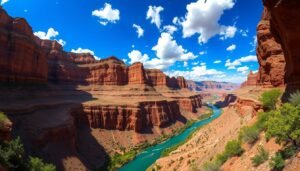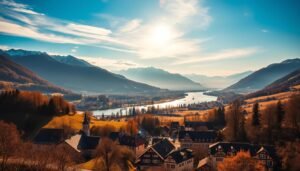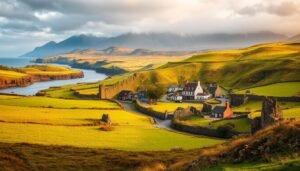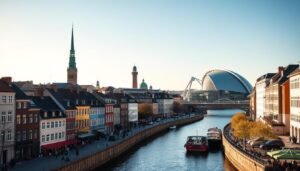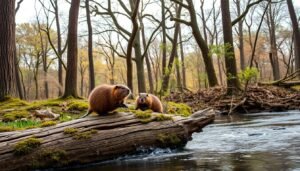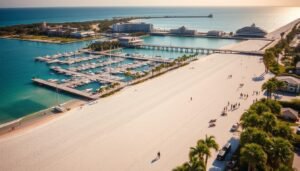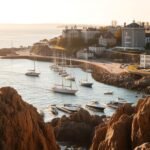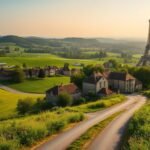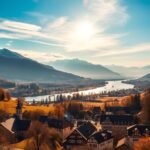Surprising fact: I learned that this country holds more than 20,000 castles and ruins, and that number alone hints at the scale of history waiting on every road and river.
On my trips I found moody forests, sunlit vineyards, and half‑timbered towns that felt like pages from a storybook. I followed the Romantic Road through Franconia, wandered UNESCO old towns like Regensburg and Bamberg, and drove the Schwarzwaldhochstraße for sweeping views.
I planned my route so regions felt distinct yet connected, using trains and scenic drives to save time and soak in the culture. I point out when summer or the holidays bring the best light and atmosphere, and I share practical tips that helped me travel smarter without rushing.
Expect a mix of iconic castles such as Neuschwanstein, glassy lakes like Eibsee, and quiet corners that felt like they were mine alone. I highlight where each place fits in the wider world of German experiences and what made me fall for them.
Key Takeaways
- I showcase historic towns, alpine lakes, and forest roads that offer memorable views.
- My route links regions so you can make the most of limited time.
- Practical tips focus on trains, scenic drives, and smart day trips.
- Best moments come from both iconic sights and quiet, lesser‑known corners.
- Seasonal timing matters—summer and holidays change light and atmosphere.
How I plan a Germany trip for history, culture, and epic views

I map anchor nights first, then slot day trips that match transit options and daylight hours. This keeps travel time low and lets me soak in each city without rushing.
When to go: I pick summer for long hikes and lake days, December for cozy markets, and shoulder seasons for museum time and fewer crowds. I often pair a mountain or lake day with an urban night so hiking and culture balance easily.
Transport choices shape my route. Germany’s ICE and Regionalbahn links make intercity hops smooth. For scenic driving, the Romantic Road and the Schwarzwaldhochstraße in the Black Forest region are unbeatable when I want pullouts and quiet views.best-time-to-visit-cancun
“I batch destinations by region and transport mode so logistics enhance the trip rather than dominate it.”
Trains, drives, and river days
- I buy advance tickets for long train hops and use regional passes for flexible stops.
- Some routes are best by car; others pair well with a Rhine or Moselle river cruise for slow, scenic travel.
- I also leave buffer time for weather on mountain and lake days so I don’t miss key views.
| Mode | Strength | When I use it |
|---|---|---|
| Train | Fast, flexible, no parking | Intercity hops and city day trips |
| Car | Scenic pullouts, remote spots | Romantic Road and Black Forest drives |
| River cruise | Slow pace, wine villages, no parking | Linking Rhine/Moselle towns |
Best places to visit in Germany
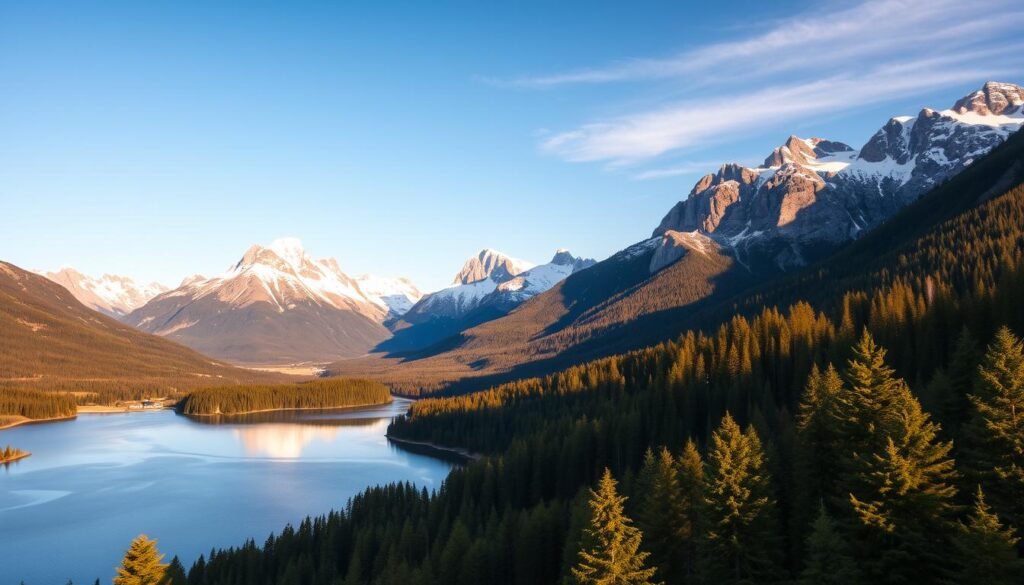
A quick tour shows where storybook lanes meet wild trails and riverside ruins. I gathered highlights that help you map a route at a glance.
Iconic towns and castles line the Romantic Road and Rhine Valley. Rothenburg ob der Tauber and the UNESCO old town areas of Regensburg and Bamberg glow with half‑timbered charm. Neuschwanstein perches above Hohenschwangau for postcard views, while Marksburg and Rheinfels anchor the Rhine between Koblenz and Bingen.best-hawaiian-island-to-visit
National parks and alpine lakes
I loved hiking the Schwarzwaldhochstraße and the treetop walk in Bavarian Forest national park. Berchtesgaden’s Königssee and Eibsee below the Zugspitze offer alpine calm and clear water.
River routes and quieter corners
The Moselle’s Burg Eltz and slow boat days pair well with wine tastings. Harz National Park and the Brocken Railway felt misty and literary. Potsdam’s Sanssouci and Würzburg Residence add palace gardens and grand frescoes for a mix of nature and art.
- I note which castles have guided interiors and which are best admired from viewpoints.
- Use this list as a quick map to chain regions and plan a first pass when you visit germany.
Rothenburg ob der Tauber and the Romantic Road

I arrived after a short drive along the Romantic Road and found Rothenburg’s medieval core easy to fall into. The town dates to 1274 and perches above the Tauber River, a location that gives its lanes a lovely riverside glow.
Old Town strolls: Plönlein, medieval walls, and Market Square
I wandered the cobblestone streets from the Plönlein corner to Market Square. I paused to climb the medieval walls and to admire half‑timbered buildings at dusk.
The town hall tower offered a panoramic view that felt worth the short climb. Inside St. Jacob’s I lingered over Riemenschneider’s late Gothic altarpiece.best-time-to-visit-bali
Along the Tauber: vineyards, Dinkelsbühl, and Harburg Castle side trips
A scenic drive continues past vineyards and rolling fields to Dinkelsbühl and Harburg Castle. These side trips are easy from Rothenburg and add calm rural scenes between busy towns.
Taste and stay: Schneeballen, Hotel Reichsküchenmeister, and Christmas vibes
I based myself near the center so I could enjoy pre-breakfast quiet lanes, especially in summer before day trippers arrived. I loved Schneeballen and a hearty breakfast at Hotel Reichsküchenmeister.
- I ducked into St. Jacob’s for the altarpiece, then climbed the town hall for a view.
- Golden-hour walks along the walls made for easy photos and slow time.
- In December the market and Christmas Museum made the streets glow like an advent calendar.
“This town is where I send friends who want a classic first taste of the region without rushing.”
Neuschwanstein Castle and Hohenschwangau

A visit to Neuschwanstein felt like stepping into a stage set carved from white stone and mountain air. Commissioned by King Ludwig II in 1869, the neuschwanstein castle towers above Hohenschwangau near Füssen and wears its Romanesque Revival style like a storybook crown.
Postcard-perfect views from Marienbrücke in the Bavarian Alps
Marienbrücke gives the classic view: the gorge, the towers, and the bavarian alps behind them. I timed my walk there after an early shuttle so the light hit the towers just right and crowds were thin.
How to tour: tickets, shuttles, and guided rooms worth seeing
Tickets sell out fast, so I booked early and picked a tour time that avoided the busiest windows. Shuttles run from the village, but I walked partway to enjoy the trails and the approach.
- Inside highlights: the Singers’ Hall and lavish interiors show Ludwig’s theatrical vision.
- Pairing: I combined neuschwanstein castle with Hohenschwangau—its guided tour (about €27.50) covers 14 rooms and terraces overlooking the Alpsee.
- Timing: In summer I chose clear mornings for the best light, leaving afternoons for lakeside walks.
“Even after a hundred photos, the scale and setting still feel surreal in person.”
Practical note: The village location makes logistics easy; I stayed overnight, grabbed dinner with a view, and left room for slow trails around the mountains so the visit felt unhurried.best-island-to-visit-in-hawaii
Regensburg’s UNESCO Old Town on the Danube
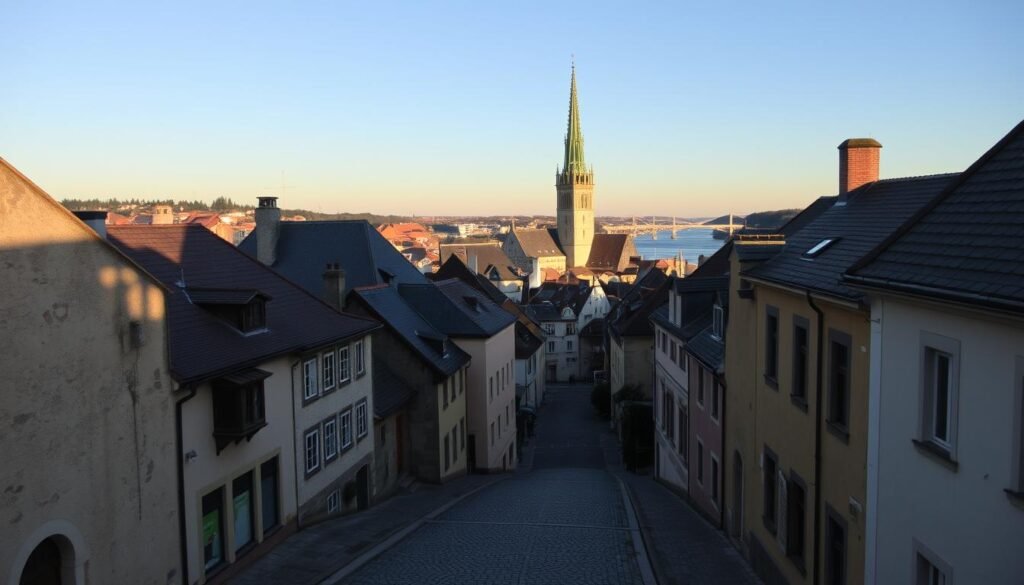
The Danube’s light changed the face of Regensburg all day, and the compact scale of the center made it easy for me to linger. The UNESCO old town sits where the Danube, Naab, and Regen meet, about 1.5 hours from Munich by road.
Stone Bridge, St. Peter’s Cathedral, and riverside beer gardens
Stone Bridge and cathedral views
I crossed the Stone Bridge at dawn and again at dusk, watching the river shift color while St. Peter’s twin spires caught the light. The pastel buildings and narrow lanes of the old town made wandering a simple joy.
Riverside beer gardens and winter markets
In summer I sat at Spitalgarten with a cold beer and a steady Danube breeze. On a winter evening the Thurn und Taxis Palace market glowed with lights and seasonal scents that felt nearly world-class.
I mixed cathedral stops and a small museum visit with lazy pauses in cafés. An easy day of walking covers the highlights and leaves room for small discoveries.
“Close quarters and long views make Regensburg one of those city gems where time slips into slow motion.”
The Black Forest: Baden‑Baden, cuckoo clocks, and mountain trails
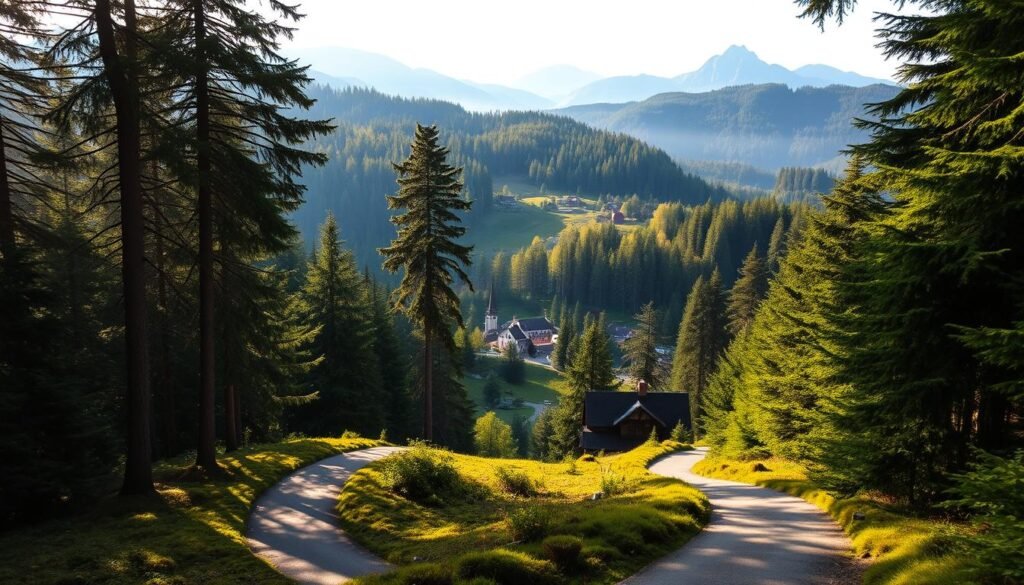
In the Black Forest I split long hikes with lazy afternoons at thermal baths and found a rhythm that fit the region.
Scenic drives and hikes: Feldberg and Schwarzwaldhochstraße
The Black Forest covers roughly 6,000 km² and borders France and Switzerland. I drove the Schwarzwaldhochstraße for wide views and pulled over for short hikes.
Feldberg is the highest peak; its trails reward compact summit panoramas and pine-scented air.
Wellness and winding streets: spas, clock museums, and cafés
I based myself in Baden‑Baden for spa time and easy access to winding streets and cafés. The German Clock Museum offered a neat look at cuckoo-clock craft and local stories.
Wellness is woven into the daily pace: hike, then steam or soak before dinner.
Family-friendly ideas: vintage trains and easy loop trails
For a family twist, I rode a vintage train like the Zapfle‑Bähnle and picked short loop trails that suit kids and slower legs.best-national-parks-to-visit-in-the-us
- I used the city as a base for spa mornings and trail afternoons.
- Summer stretched the days, so I mixed driving, hiking, and relaxed village stops.
- The timbered towns and bakery corners made slow starts feel charming.
“This slice of visit germany blends folklore charm with modern comforts.”
Bamberg’s Little Venice and half-timbered charm
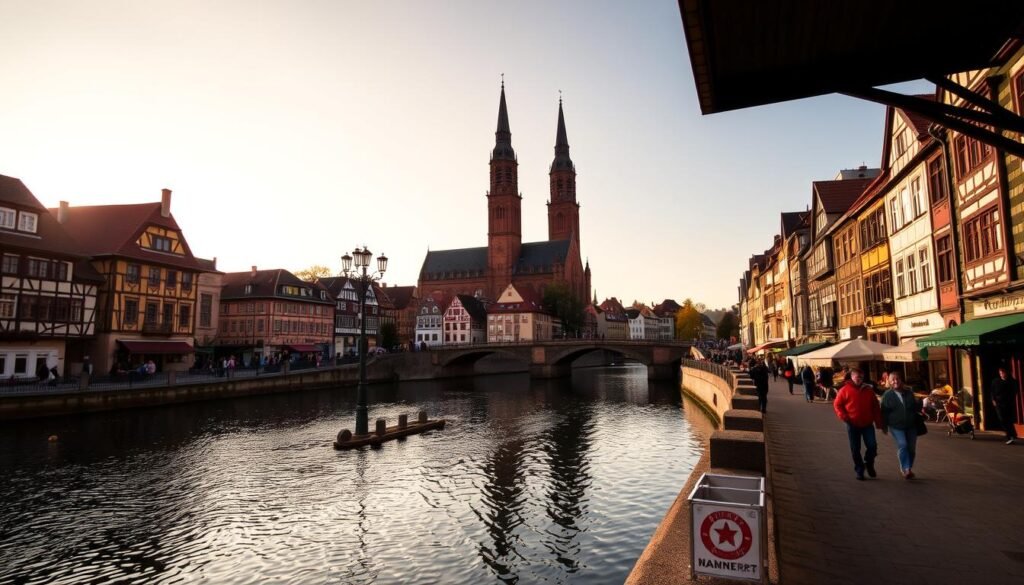
A stroll through Bamberg felt slow and layered, with the Regnitz threading medieval and Baroque corners together. The UNESCO old town spreads along the river, where bridges and waterfront houses create a reflective calm.
I crossed to the Altes Rathaus and admired its improbable perch above the water. Then I meandered through narrow streets lined with half‑timbered homes and tiny courtyards.
The layers of history showed in ornate church facades and in quiet lanes. I lingered in the rose gardens above the cathedral for a high view of rooftops and waterways below.
Altes Rathaus, rose gardens, and a Rauchbier toast
I made space for a long lunch and a slow late‑afternoon wander. Museum stops slotted in easily between strolls, since the center is compact and walkable.
- I crossed to the Altes Rathaus, then wandered streets of timbered houses.
- I paused in the rose gardens for a quiet panorama over the river.
- I toasted the day with a smoky Rauchbier at Schlenkerla and tasted local wine pairings.
- Everything felt set for taking your time—and it rewarded me with hidden corners and soft river reflections.
“Bamberg’s calm pace made it the kind of town where lingering pays off.”
Lake Königssee and Berchtesgaden National Park
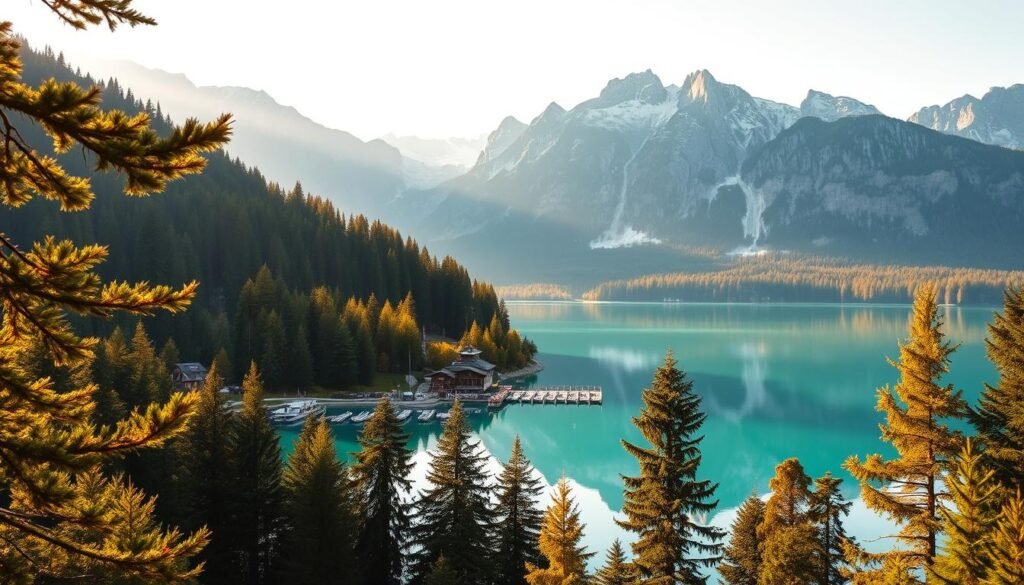
At Lake Königssee, the water sat like glass beneath steep green walls and a hush that felt intentional.
I took the silent electric boat across emerald water to St. Bartholomew’s and waited for the famous Echo Wall reply. The chapel’s red domes set against deep forest made photos simple and striking.
Electric boat, the Echo Wall, and lakeside time
From the landing I wandered gentle shoreline paths before the next departure. The location inside Berchtesgaden national park kept the scene feeling protected, even during busy summer days.
Jenner cable car, alpine trails, and panoramic summits
I rode the Jenner cable car and linked short alpine trails for sweeping panoramas. Trails ranged from easy lakeside loops to steeper ridge walks, so I matched my pace to the weather and my available time.
“A morning boat, a midday Jenner hike, and a late-afternoon shore walk made the day feel perfectly paced.”
- I heard the Echo Wall call bounce off the cliffs.
- I planned for quiet moments between boat departures.
- The river-fed lake and slopes offered steady, unforgettable views.
Bavarian Forest National Park in winter
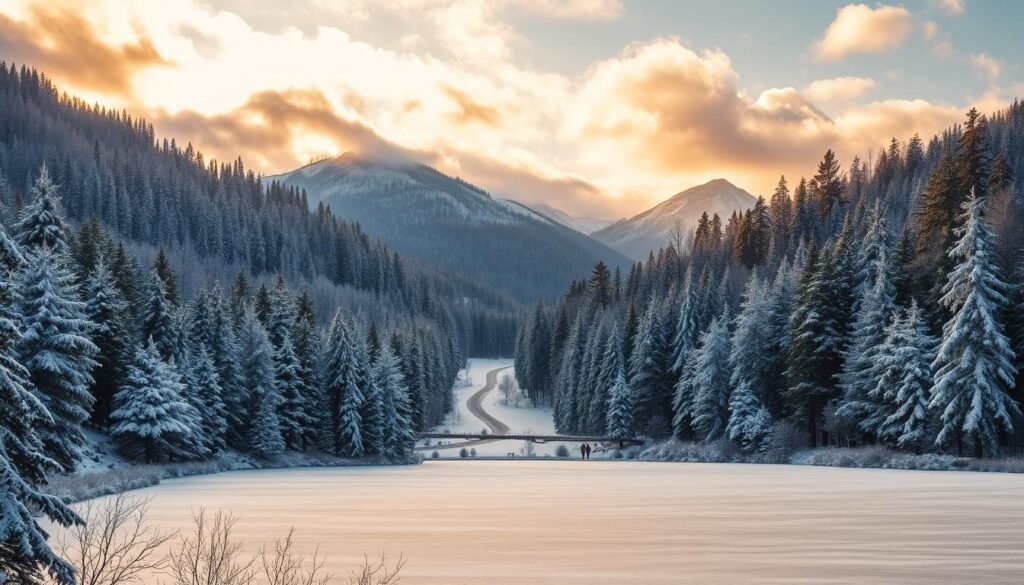
Snow muffled the forest and made each footstep feel like a small discovery. I explored an area that was set aside in 1970 and now covers roughly 24,250 hectares along the Czech border.best-places-to-visit-in-europe
The treetop walk at Neuschönau gave me an elevated view over a frosted canopy. It swayed just enough to be thrilling and offered a clear sense of scale for the whole park.
Treetop walk, wildlife spotting, and snow-laden trails
I started my day at the Hans‑Eisenmann‑Haus Visitor Centre to check conditions and learn about rewilding efforts. Staff pointed out recent tracks and suggested safe loops for the current trails.
Tracks in the snow slowed me down. I scanned the woods for lynx prints, deer paths, and the rare three‑toed woodpecker. During a quiet hour I even glimpsed signs of European bison and black stork activity.
- I budgeted time for short loops and one longer route so I could turn back if the path iced over.
- Winter can be icy; I used sturdy boots and poles and kept my pace steady.
- Though I came for the hush of winter, I made a note to return in summer to see leaves and light change the same paths.
“The park felt gentle on the landscape and heavy on the hush.”
The Rhine Valley: castles, vineyards, and river towns
The Middle Rhine felt like a ribbon of stone and vine, where fortress walls and terraced slopes frame a slow-moving corridor that invites lingering.
Marksburg, Rheinfels, and the Lorelei Rock along the Rhine River
I toured Marksburg for its intact keeps and climbed at Rheinfels for dramatic ruin views. I spent an afternoon at the Lorelei bend, watching barges thread the narrow curve while cliffs told their own stories.
Bacharach, Rüdesheim, and wine tasting in candle-lit taverns
Town quays like Bacharach and Rüdesheim feel intimate. Candle-lit taverns and the RheinWeinWelt offered Rieslings that speak of slate and sun. I split days between castle tours and relaxed wine stops.
Rheinsteig Trail stages for day hikers with big views
For trails I picked a Rheinsteig stage that climbs from river level to open panoramas. From those ridges the boats, vines, and compact city roofs look small and tidy below.
- I based myself along the Rhine to mix ferries, short trains, and footpaths.
- Summer shows this corridor at its brightest, but shoulder seasons bring softer light and fewer crowds.
- The UNESCO Middle Rhine is a world-class corridor that rewards a slow, flexible plan — a perfect way to visit germany for a day or two.
“A mix of castles, vineyards, and a short hike makes the Rhine feel both grand and perfectly manageable.”
Bremen’s Market Square and the Schnoor Quarter
I began my Bremen day at the UNESCO Market Square, where ornate façades and the bronze Roland statue set a dignified tone. The Town Hall’s carved details invite a slow look, and the square feels like the heart of this compact city.
I moved from the square into the city center and found lanes that reward wandering. The Schnoor Quarter’s narrow alleys and crooked half‑timbered buildings made me slow down and notice small doorways and tiled signs.
The Schlachte Promenade runs along the Weser and offers a breezy riverside walk. I grabbed a riverside seat, watched barges pass, and let the afternoon unfold at café tables with local pastry and coffee.
Even with tourist energy near the statues, it’s easy to slip into quiet courtyards and feel the old center’s pulse. I left myself time to get lost; in a compact area, that’s the best way to find galleries and artisan shops.
“Between photo stops and coffee breaks, I found the balance that makes a city break feel like a true getaway.”
The Moselle Valley and fairytale Burg Eltz
I let a day on the Moselle set my pace: boats, bikes, and terraced slopes guided where I stopped and lingered.
The stretch between Trier and Koblenz pairs vine‑covered hills with slow river views and tiny, storybook villages. Burg Eltz crowns a forested ridge and feels like a castle borrowed from a fairytale.best-time-to-visit-greece
Slow travel by boat, bikes, and hillside trails
I spent a summer day mixing a morning castle walk with an afternoon cycle. Boats moved gently between towns while I chose quiet trails that climb through terraces.
Wine country: biodynamic Rieslings and river-view tastings
I set a tasting at Weingut Rita & Rudolf Trossen and found sulfite‑free Rieslings that tasted of slate and stone fruit. Sitting with a river view made each glass feel like part of the landscape.
- Rhythm: a castle visit, a bike ride, and an evening tasting fit neatly into light hours.
- Vineyards: terraced rows wrap the hills and glow at golden hour.
- Villages along river: spires, squares, and cafés appear one after another—perfect for slow stops.
“Less planning here meant more discoveries; the river set the rhythm and I followed.”
Harz National Park and the Brocken Railway
I boarded a vintage locomotive that pulled me through a forested world of moss, myths, and narrow‑gauge rails. Harz National Park spans about 247 km² across Lower Saxony and Saxony‑Anhalt, and the steam-powered Brocken Railway climbs to the Brocken, the highest peak in northern Germany.
Steam trains, misty forests, and half-timbered towns
The ride smelled of coal and pine, and the slow climb turned the journey into a moving tour. Trails branch off to viewpoints and quiet clearings, so I paired the train with short hikes for a fuller day.
Legend and literature: witches, Walpurgisnacht, and Goethe
Half‑timbered towns like Wernigerode and Quedlinburg charmed me with colorful facades and snug squares built for lingering. The modest mountains carry a rich history of witches, Walpurgisnacht, and writers such as Goethe.
- I rode the steam train toward the Brocken, feeling the pace set by rails and forest.
- The Harzer‑Hexen‑Stieg and short loops made hiking easy and flexible.
- In a world of fast travel, the Harz gave me time to slow down and let each path tell a story.
“The Brocken climb felt like stepping into a lined page of folklore—fog, rails, and tales that linger.”
Würzburg Residence and court gardens
A short walk from the Old Main Bridge brought me to a palace whose scale still surprised me. The Würzburg Residence, finished in 1744 and now a UNESCO site, sits like a grand punctuation in the city.
Baroque splendor: Tiepolo frescoes and the grand staircase
I joined a guided tour for context and learned why the ceiling scenes dominate every room. Tiepolo’s monumental frescoes pull your eye upward, and the opulent grand staircase steals your first view.
The complex of buildings and manicured court gardens reads like a planned stage. Entry costs about €10, and the rooms hold a treasure-filled collection that reads like living history.
- I toured the Residence to see Tiepolo’s frescoes and the dramatic staircase that steals every visitor’s first view.
- The symmetry of the palace and the gardens’ geometry made my city stop feel regal and restful.
- I lingered by the Mirror Cabinet and White Hall, taking my time so details sank in.
| Feature | Highlight | Visitor note |
|---|---|---|
| Grand Staircase | Tiepolo frescoes | Best seen on the guided tour |
| Court Gardens | Geometric layout, fountains | Great for a quiet pause |
| Collections | Salons, cabinets, art | Museum-like rooms with labels |
“I found that learning who lived here made the lavish rooms read as stories rather than decor.”
For planning, consider a midday visit and pair it with riverside walks. If you want structured context, book a guided Würzburg Residence tours and leave extra time for the gardens and a final look back at the façade.
Eibsee below the Zugspitze
I reached Eibsee at dawn and watched the lake turn from ink to turquoise as the sun climbed behind the Zugspitze.
The location near Grainau sits right at the foot of the mountains. Tiny islands and clear shallows make every shoreline feel private.
I planned a slow day around light. In the morning the water mirrored peaks. By late afternoon the color shifted and the scene changed again.
- Lakeside trails wrap coves and offer fresh views every few steps.
- Boat and pedal-boat rentals let me drift into open water and frame the mountains.
- The Eibsee Hotel sits above the shore, handy if you want an early start or a calm evening.
“It’s the place I go for serenity and scenery without a complicated plan.”
| Feature | Why I liked it | Visitor tip |
|---|---|---|
| Water color | Turquoise shades around islands | Walk the loop for changing tones |
| Boat rentals | Quiet access to open lake | Go early in summer for calm water |
| Lakeside trails | Short walks with peak views | Bring light layers; weather shifts fast |
Mittenwald’s murals and mountain melodies
Mittenwald’s painted facades greeted me like a small, lively gallery tucked beneath high peaks. I wandered narrow lanes paced by Lüftlmalerei scenes that turn each house into a story. The compact city center felt friendly and easy to explore on foot.
Frescoed streets, violin-making, and Karwendelbahn views
The Geigenbaumuseum explains why this place grew a craft of sound as much as wood. I loved seeing instruments and tools that link local timber, technique, and tuning.
I rode the Karwendelbahn for sweeping 360° views over the Karwendel and Wetterstein ranges. The ride gave me a quick taste of the mountains without a long approach.
- I wandered frescoed streets in the compact city center, where mural scenes dance across house fronts.
- The violin-making museum connects craft to the landscape—wood, resonance, and tradition.
- In summer I followed easy paths from town, then settled at a café terrace as evening fell.
“An unplanned hour here became a perfect afternoon, with mountains framing every corner.”
That blend of artistry and alpine charm makes Mittenwald a place I’m always happy to return to. For a practical read on timing and routes, see my notes about a day in Mittenwald.
Potsdam’s Sanssouci Palace and gardens
I took a short train hop from Berlin and stepped straight into a sunlit world of terraces, fountains, and rococo detail.
Sanssouci began as Frederick the Great’s pleasure palace, set on terraced vineyards with a six-step staircase and a central fountain. The rococo complex blends architecture, sculpture, and garden art.
The site joined the UNESCO World Heritage List in 1990, and the Picture Gallery holds a compact art collection that rewards a calm hour.
Easy day trip from Berlin by train
I planned a simple train hop and used my time on foot. The palace grounds are walkable, so I paired a guided tour with café breaks along leafy avenues.
A tour adds context: hearing about court life and the palace’s history made the ornamentation feel like part of a lived story rather than just decor.
“The terraces of vineyards and the palace’s rococo lines make every angle a painter’s study.”
| Feature | Why it mattered | Visitor tip |
|---|---|---|
| Terraced vineyards | Creates layered views and formal axes | Walk the staircase for classic perspectives |
| Picture Gallery | Holds fine paintings and intimate salons | Set aside time for a quiet visit |
| UNESCO listing | Recognizes integrated park and architecture | Expect guided groups; arrive early |
- I slipped between sculptures and fountains and let the gardens set my pace.
- The location in Potsdam lets you pair palace time with cafés and leafy avenues before returning to the city.
- For me, Sanssouci felt like the part of greater Berlin that offers elegant green space without extra fuss.
Practical note:book a guided tour if you want the layered history; otherwise, give yourself time to wander and savor the design.
Conclusion
I learned that quick train rides or a short drive can move you from alpine peaks to riverside lanes in a single day. Small hops let you pack more feeling into each hour and keep logistics simple.
Pick one part to savor or string together towns and a city for a longer arc. Plan around light and pace your time so mornings and late strolls reveal quieter corners and iconic views alike.
My hope is that this guide helps you map a trip that blends history, culture, and scenery. If you visit germany, leave room for detours—in one germany there’s space for both famous sights and private moments.






